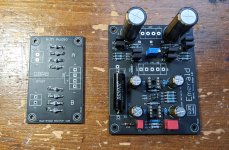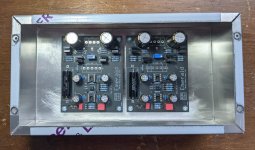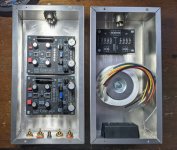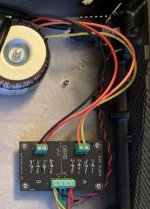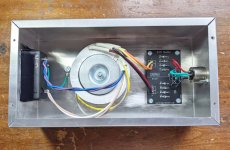Is there a way to add a digital conversion stage to your build? Has anyone done it? I have a minidsp that I would like to feed with this and it has only digital inputs.
Last edited:
My package arrived today in less than two weeks. That seems pretty quick to me.
That's good news, hopefully that means delivery times are coming back to normal.
@ldarieut
Thinking of the chassis as a "preamplifier" you can add whatever additional functionality you need, including an analog-to-digital converter. The stages are all independent of each other, except for the signal lines.
Funny, I always build both boards in parallel, step-by-step, rather than complete one first then the next.
Funny, I always build both boards in parallel, step-by-step, rather than complete one first then the next.
That makes sense. I was concerned about making one mistake, not two, I guess, i.e., I'd have a correct assembly to check the second one against.
Here's a test fit with the standoffs in a Hammond 1444-9553 aluminum chassis (9 1/2" x 5" x 3"). Yes, this is a budget build. These chassis are only $13.40 each from Hawk, and can be painted. My initial plan is to make hardwood lids and laser engrave an "RJM Audio Emerald" logo on them at work.
The boards fit good with plenty of room on the short sides for the jacks and wires.
Attachments
Progress. This project was a lot of fun, straightforward and very well documented. Thanks Richard!
I just need to wire things up, and buy an XLR cable (the one thing I overlooked in my original order).
Then, it will be on to the power-up and testing stage. It should be a great addition to my Tubelab SSE that I built last year!
David
I just need to wire things up, and buy an XLR cable (the one thing I overlooked in my original order).
Then, it will be on to the power-up and testing stage. It should be a great addition to my Tubelab SSE that I built last year!
David
Attachments
That's coming along nicely. Remember that you'll need occasional access to the boards to change the jumper settings, unless you route the jumper to panel switches.
Thanks Richard. Right now I'm a "one turntable/one cartridge" person. But, if I ever do buy some different cartridges it should be easy enough to remove the chassis lid to make changes.
I'm confused about the Triad VPM24-1040 primaries. Looking at the 120VAC instructions from the Triad datasheet:
Is it telling me to twist the White and Brown wires together and the Blue and Violet wires together and then connect the incoming Line to one pair and the Neutral to the other pair for 120VAC?
I assume the secondaries are wired like the photo below; Red and Black to one bridge and Yellow and Orange to the other bridge.
Thanks for the help with is. Transformers with multiple windings always confuse me.
I'm confused about the Triad VPM24-1040 primaries. Looking at the 120VAC instructions from the Triad datasheet:
Is it telling me to twist the White and Brown wires together and the Blue and Violet wires together and then connect the incoming Line to one pair and the Neutral to the other pair for 120VAC?
I assume the secondaries are wired like the photo below; Red and Black to one bridge and Yellow and Orange to the other bridge.
Thanks for the help with is. Transformers with multiple windings always confuse me.
Attachments
@dwinstonwood; nice work. Looking forward to seeing it complete. Keep posting pictures of your progress ����
I'm confused about the Triad VPM24-1040 primaries. Looking at the 120VAC instructions from the Triad datasheet:
Is it telling me to twist the White and Brown wires together and the Blue and Violet wires together and then connect the incoming Line to one pair and the Neutral to the other pair for 120VAC?
The datasheet doesn't make it as obvious as it could be. For 120 V connect the primaries in parallel. Blue/violet to live, Wht/Brn to neutral for example.
Can someone recommend a toroidal transformer for eu 220-240? Is this one ok:
Transformateur Torique 30VA 2x12V - Audiophonics
Another question, is regular canare starquad 6mm wire adequate for xlr 12v power?
Thanks!
Transformateur Torique 30VA 2x12V - Audiophonics
Another question, is regular canare starquad 6mm wire adequate for xlr 12v power?
Thanks!
Thanks, I didn’t see it was also 240vac. It’s settled then 🙂Why not use the Triad from the BOM? It's 110-240VAC input.
Set the trimmer so that the voltage between V- and REF is the same as that between V+ and REF. I do it before I put the ICs in and then I check it again when it's all up and running.
Everything looks proper and correct. Note that these power supplies can be re-purposed for a wide range of audio projects.
Thanks Richard. Wow, that didn't occur to me about the PSU. Maybe I should have purchased two or three rectifier kits and built them at the same time.
I've added the wiring to the boards (soldered from underneath).
Since I saved a bunch with the Hammond enclosures, I felt justified in spending a bit more on coupling caps. I'm sure the Bennics are fine, but these Jantzen Superior Z-Caps get good reviews and are only about $18 a piece, so I ordered a couple. Maybe they'll get here tomorrow.
Jantzen Superior Z-Cap, 2.20µF 800VDC
I've added the wiring to the boards (soldered from underneath).
Since I saved a bunch with the Hammond enclosures, I felt justified in spending a bit more on coupling caps. I'm sure the Bennics are fine, but these Jantzen Superior Z-Caps get good reviews and are only about $18 a piece, so I ordered a couple. Maybe they'll get here tomorrow.
Jantzen Superior Z-Cap, 2.20µF 800VDC
Attachments
A quick word on caps. The Bennic caps are just acceptable, and I strongly recommend upgrading to something better. That said, a lot of expensive caps are aimed at tube amps and have very high voltage ratings, like your 800V Jantzen. That's not a problem exactly, but it does mean the cap is larger and more expensive than it needs to be.
If you can, try to find something that is of high quality but still comes in convenient 200 V voltage models.
If you can, try to find something that is of high quality but still comes in convenient 200 V voltage models.
- Home
- Source & Line
- Analogue Source
- RJM Audio Emerald Phono Stage Help Desk
